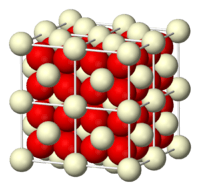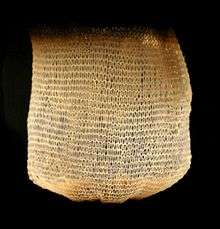Cerium(IV) oxide
_oxide.jpg) | |
 | |
| Names | |
|---|---|
| IUPAC name
Cerium(IV) oxide | |
| Other names
Ceric oxide, Ceria, Cerium dioxide | |
| Identifiers | |
| 1306-38-3 12014-56-1 (monohydrate) | |
| 3D model (Jmol) | Interactive image |
| ChEBI | CHEBI:79089 |
| ChemSpider | 8395107 |
| ECHA InfoCard | 100.013.774 |
| PubChem | 73963 |
| UNII | 619G5K328Y |
| |
| |
| Properties | |
| CeO2 | |
| Molar mass | 172.115 g/mol |
| Appearance | white or pale yellow solid, slightly hygroscopic |
| Density | 7.215 g/cm3 |
| Melting point | 2,400 °C (4,350 °F; 2,670 K) |
| Boiling point | 3,500 °C (6,330 °F; 3,770 K) |
| insoluble | |
| Structure | |
| cubic (fluorite)[1] | |
| Hazards | |
| NFPA 704 | |
| Related compounds | |
| Related compounds |
Cerium(III) oxide |
| Except where otherwise noted, data are given for materials in their standard state (at 25 °C [77 °F], 100 kPa). | |
| | |
| Infobox references | |
Cerium(IV) oxide, also known as ceric oxide, ceric dioxide, ceria, cerium oxide or cerium dioxide, is an oxide of the rare earth metal cerium. It is a pale yellow-white powder with the chemical formula CeO2. It is an important commercial product and an intermediate in the purification of the element from the ores. The distinctive property of this material is its reversible conversion to a nonstoichiometric oxide.[2]
Production
Cerium occurs naturally as a mixture with other rare earth elements in its principal ores bastnaesite and monazite. After extraction of the metal ions into aqueous base, Ce is separated from that mixture by addition of an oxidant followed by adjustment of the pH. This step exploits the low solubility of CeO2 and the fact that other rare earth elements resist oxidation.[2]
Cerium(IV) oxide is formed by the calcination of cerium oxalate or cerium hydroxide.
Cerium also forms cerium(III) oxide, Ce
2O
3, which is an unstable that will oxidize to cerium(IV) oxide.[3]
Structure and defect behavior
Cerium oxide adopts the fluorite structure, space group Fm3m, #225 containing 8-coordinate Ce4+ and 4 coordinate O2−. At high temperatures it releases oxygen to give a non-stoichiometric, anion deficient form that retains the fluorite lattice. This material has the formula CeO(2-x) where 0 < < 0.28.[4] The value of depends on both the temperature and the oxygen partial pressure. The equation
has been shown to predict the equilibrium non stoichiometry over a wide range of oxygen partial pressures (103 - 10−4 Pa) and temperatures (1000-1900 °C).[5]
The non stoichiometric form has a blue to black color, and exhibits both ionic and electronic conduction with ionic being the most significant at temperatures > 500 °C. [6]
The number of oxygen vacancies is frequently measured by using X-ray photoelectron spectroscopy to compare the ratios of Ce3+
to Ce4+
.
Defect chemistry
In the most stable fluorite phase of ceria, it exhibits several defects depending on partial pressure of oxygen or stress state of the material.[7][8]
The primary defects of concern are oxygen vacancies and small polarons (electrons localized on cerium cations). Increases in the number of oxygen defects increases the diffusion rate of oxide in the lattice as reflected in an increase in ionic conductivity. These factors recommend ceria as a solid electrolyte in solid-oxide fuel cells. Undoped and doped ceria also exhibit high electronic conductivity at low partial pressures of oxygen due to reduction of the cerium ion leading to the formation of small polarons. Since the oxygen atoms in a ceria crystal occur in planes, diffusion of these anions is facile. The diffusion rate increases as the defect concentration increases.
Polishing applications
The principal application of ceria is for polishing, especially chemical-mechanical planarization (CMP).[2] For this purpose, it has displaced many other oxides that were previously used, such as iron oxide and zirconia. For hobbyists, it is also known as "optician's rouge".[9] [10]
Other uses
CeO2 is used to decolorize glass by converting green-tinted ferrous impurities to nearly colorless ferric oxides.[2]
Cerium oxide has found use in infrared filters, as an oxidizing species in catalytic converters and as a replacement for thorium dioxide in incandescent mantles[11]
Catalysis
The interconvertibility of CeOx materials is the basis of the use of ceria for an oxidation catalyst. One small but illustrative use is its use in the walls of self-cleaning ovens as a hydrocarbon oxidation catalyst during the high-temperature cleaning process. Another small scale but famous example is its role in oxidation of natural gas in gas mantles.[12]
Ceria has been used as a sensor in catalytic converters in automotive applications, controlling the air-exhaust ratio to reduce NOx and carbon monoxide.
Mixed conduction
Due to the significant ionic and electronic conduction of cerium oxide, it is well suited to be used as a mixed conductor.[13]
Research
Fuel cells
Ceria is of interest as a material for solid oxide fuel cells (SOFCs) because of its relatively high oxygen ion conductivity (i.e. oxygen atoms readily move through it) at intermediate temperatures (500–650 °C) and lower association enthalpy compared to Zirconia system.[14]
Water splitting
The cerium(IV) oxide–cerium(III) oxide cycle or CeO2/Ce2O3 cycle is a two step thermochemical water splitting process based on cerium(IV) oxide and cerium(III) oxide for hydrogen production.[15]
References
- ↑ Pradyot Patnaik. Handbook of Inorganic Chemicals. McGraw-Hill, 2002, ISBN 0-07-049439-8
- 1 2 3 4 Klaus Reinhardt and Herwig Winkler in "Cerium Mischmetal, Cerium Alloys, and Cerium Compounds" in Ullmann's Encyclopedia of Industrial Chemistry 2000, Wiley-VCH, Weinheim. doi:10.1002/14356007.a06_139
- ↑ Thermodynamic data Archived October 29, 2013, at the Wayback Machine.
- ↑ Defects and Defect Processes in Nonmetallic Solids By William Hayes, A. M. Stoneham Courier Dover Publications, 2004
- ↑ Bulfin, B.; Lowe, A. J.; Keogh, K. A.; Murphy, B. E.; Lübben, O.; Krasnikov, S. A.; Shvets, I. V. (2013). "Analytical Model of CeO2 Oxidation and Reduction". The Journal of Physical Chemistry C. 117 (46): 24129–24137. doi:10.1021/jp406578z.
- ↑ Ghillanyova, K; Galusek, D (2011). "Chapter 1: Ceramic oxides". In Riedel, Ralf; Chen, I-Wie. Ceramics Science and Technology, Materials and Properties, vol 2. John Wiley & Sons. ISBN 978-3-527-31156-9.
- ↑ Munnings,, C; SPS Badwal; D Fini (2014). "Spontaneous stress-induced oxidation of Ce ions in Gd-doped ceria at room temperature". Ionics. 20 (8): 1117–1126. doi:10.1007/s11581-014-1079-2.
- ↑ Badwal, SPS; Daniel Fini; Fabio Ciacchi; Christopher Munnings; Justin Kimpton; John Drennan (2013). "Structural and microstructural stability of ceria – gadolinia electrolyte exposed to reducing environments of high temperature fuel cells". J. Mater. Chem. A. 1 (36): 10768. doi:10.1039/C3TA11752A.
- ↑ Properties of Common Abrasives (Boston Museum of Fine Arts)
- ↑ MFA Materials database.
- ↑ Cerium dioxide. nanopartikel.info
- ↑ Greenwood, Norman N.; Earnshaw, Alan (1997). Chemistry of the Elements (2nd ed.). Butterworth-Heinemann. ISBN 0-08-037941-9.
- ↑ "Mixed conductors". Max Planck institute for solid state research. Retrieved 16 September 2016.
- ↑ "Electrical conductivity of the ZrO2–Ln2O3 (Ln=lanthanides) system". Solid State Ionics. 121: 133–139. doi:10.1016/S0167-2738(98)00540-2.
- ↑ Hydrogen production from solar thermochemical water splitting cycles Archived August 30, 2009, at the Wayback Machine.. solarpaces.org
External links
| Wikimedia Commons has media related to Cerium(IV) oxide. |

